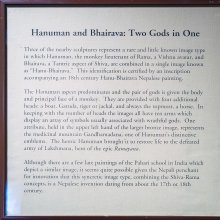Gandhamadana, Gamdhamadana, Gandha-madana, Gandhamādana: 27 definitions
Introduction:
Gandhamadana means something in Buddhism, Pali, Hinduism, Sanskrit, Jainism, Prakrit, the history of ancient India. If you want to know the exact meaning, history, etymology or English translation of this term then check out the descriptions on this page. Add your comment or reference to a book if you want to contribute to this summary article.
Gandhamadana has 25 English definitions available.
Images (photo gallery)
Languages of India and abroad
Sanskrit dictionary
[Deutsch Wörterbuch]
Source: Cologne Digital Sanskrit Dictionaries: Böhtlingk and Roth Grosses Petersburger WörterbuchGandhamādana (गन्धमादन):—(ga + mā) durch seinen Geruch betäubend:
1) m. a) eine Art Biene [Hemacandra’s Anekārthasaṃgraha 5, 26.] [Medinīkoṣa Nalopākhyāna 234.] — b) Schwefel (vgl. gandhamodana) diess. — c) Nomen proprium eines wegen seiner schön duftenden Wälder hochgerühmten Gebirges [Trikāṇḍaśeṣa 2, 3, 4.] [Hemacandra’s Anekārthasaṃgraha] [Lassen’s Indische Alterthumskunde I, 842.] [Mahābhārata 3, 471. 1496. 10861. 8, 2104.] [Arjunasamāgama 11, 10.] [Harivaṃśa 9735. 11447. 12163. 12417.] [Rāmāyaṇa 2, 54, 28. 4, 44, 54. 5, 17, 18. 6, 3, 30. 82, 38.] [Kumārasaṃbhava 6, 46.] [Viṣṇupurāṇa 168. 169. 171. 180.] [Bhāgavatapurāṇa 5, 16, 10.] [Hemacandra’s Abhidhānacintāmaṇi 1538, Scholiast] [Burnouf 178. 396. 400.] [Lot. de Lassen’s Anthologie b. l. 847.] [Lebensbeschreibung Śākyamuni’s 267 (37).] Nach [Medinīkoṣa] auch neutr., vgl. jedoch [Mallinātha] zu [Kumārasaṃbhava 6, 46.] Aller Wahrscheinlichkeit nach ist durch das m. das Gebirge, durch das n. der darauf stehende Wald bezeichnet worden. — d) ein Beiname Rāvaṇa’s, des Oberherrn der Rakṣas: rākṣasādhipatiścaiva mahendro gandhamādanaḥ [Mahābhārata 2, 410.] Ebendaselbst 412 bezeichnet mahendro gandhamādanaḥ das oben angeführte Gebirge. — c) Nomen proprium eines Affen im Gefolge von Rāma [Hemacandra’s Anekārthasaṃgraha] [Medinīkoṣa] gandhamādanavāsī tu prathito gandhamādanaḥ [Mahābhārata 3, 16273.] [Rāmāyaṇa 1, 16, 13. 4, 25, 33. 39, 18. 5, 73, 26. 6, 69, 43. 82, 53.] —
2) f. ī a) ein berauschendes Getränk [Trikāṇḍaśeṣa 2, 10, 15.] [Hemacandra’s Anekārthasaṃgraha] [Medinīkoṣa] — b) Schmarotzerpflanze (vandāka). — c) ein best. Parfum (cīḍā) [Rājanirghaṇṭa im Śabdakalpadruma]
--- OR ---
Gandhamādana (गन्धमादन):—
1) c) n. [Amarakoṣa 2, 3, 3.]
Source: Cologne Digital Sanskrit Dictionaries: Sanskrit-Wörterbuch in kürzerer FassungGandhamadana (गन्धमदन):—(metrisch) m. = gandhamādana
1) c) [Hemādri’s Caturvargacintāmaṇi 1,351,2.]
--- OR ---
Gandhamādana (गन्धमादन):——
1) m. — a) *eine Bienenart. — b) *Schwefel. — c) Nomen proprium eines (oder verschiedener) Gebirges mit schön duftenden Wäldern [VP.².,] n. verdächtig. — d) Beiname Rāvaṇa's. — e) Nomen proprium eines Affen. —
2) *f. ī — a) ein berauschendes Getränk. — b) Schmarotzerpflanze. — c) ein best. Parfum.
Sanskrit, also spelled संस्कृतम् (saṃskṛtam), is an ancient language of India commonly seen as the grandmother of the Indo-European language family (even English!). Closely allied with Prakrit and Pali, Sanskrit is more exhaustive in both grammar and terms and has the most extensive collection of literature in the world, greatly surpassing its sister-languages Greek and Latin.
See also (Relevant definitions)
Partial matches: Madana, Gandha.
Starts with: Gandhamadanaparvata, Gandhamadanavarisha.
Full-text (+133): Gandhamodana, Gandhamadanavarisha, Bhujaka, Amaragandika, Kamuka, Saptaparvata, Kantamatanam, Gandhamadanaparvata, Ashtakulacala, Ashvaratha, Suriyagabbha, Gandhamadani, Bahusodari, Kapi, Nagapalivethana, Candagabbha, Cullakala, Suvannapassapabbata, Mahakitaparvata, Bhadrashva.
Relevant text
Search found 60 books and stories containing Gandhamadana, Gamdhamadana, Gaṃdhamādana, Gandha-madana, Gandha-mādana, Gandhamādana; (plurals include: Gandhamadanas, Gamdhamadanas, Gaṃdhamādanas, madanas, mādanas, Gandhamādanas). You can also click to the full overview containing English textual excerpts. Below are direct links for the most relevant articles:
Garga Samhita (English) (by Danavir Goswami)
Verse 3.10.15 < [Chapter 10 - The Glory of Śrī Girirāja]
Verse 2.11.34 < [Chapter 11 - The Liberation of Dhenukāsura]
Verse 1.15.67 < [Chapter 15 - Revelation of the Universal Form to Nanda’s Wife]
The Linga Purana (by J. L. Shastri)
Chapter 49 - Ilāvṛta sub-continent < [Section 1 - Uttarabhāga]
Chapter 47 - Bhārata sub-continent (bharatavarṣa) < [Section 1 - Uttarabhāga]
Chapter 48 - The Mountain Meru < [Section 1 - Uttarabhāga]
Brihad Bhagavatamrita (commentary) (by Śrī Śrīmad Bhaktivedānta Nārāyana Gosvāmī Mahārāja)
Verse 1.4.29 < [Chapter 4 - Bhakta (the devotee)]
Verse 2.2.107 < [Chapter 2 - Jñāna (knowledge)]
Verse 2.2.110 < [Chapter 2 - Jñāna (knowledge)]
Sahitya-kaumudi by Baladeva Vidyabhushana (by Gaurapada Dāsa)
Text 10.156 < [Chapter 10 - Ornaments of Meaning]
The Vishnu Purana (by Horace Hayman Wilson)
Chapter XXIV - Mucukunda departed to Gandhamadana to perform penance < [Book V]
Chapter II - Description of the earth (the seven Dvipas and seven seas) < [Book II]
Chapter I - Descendants of Priyavrata, the eldest son of Svayambhuva Manu < [Book II]
List of Mahabharata people and places (by Laxman Burdak)
Related products

